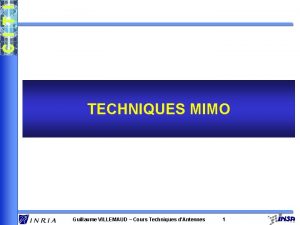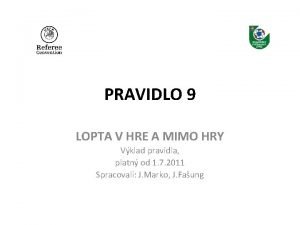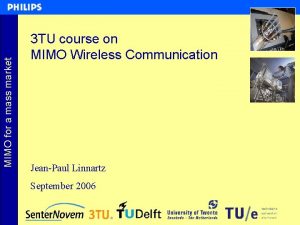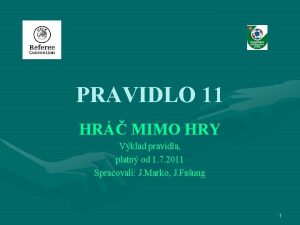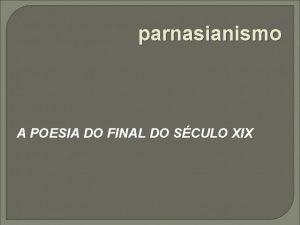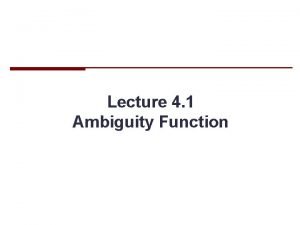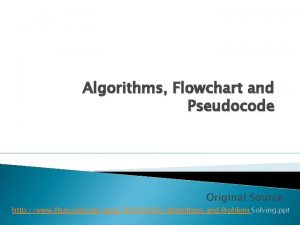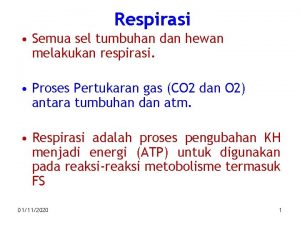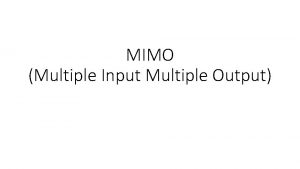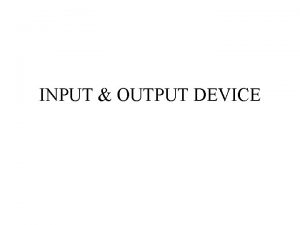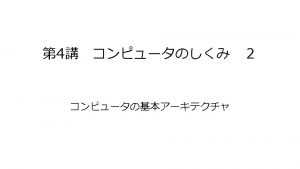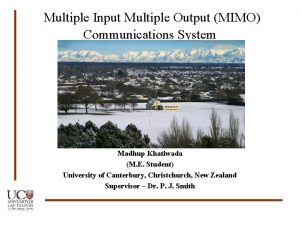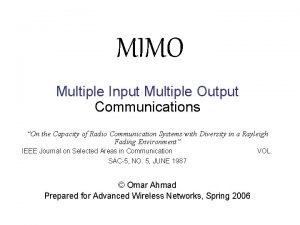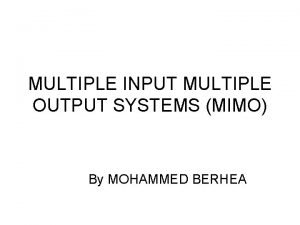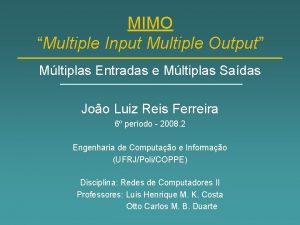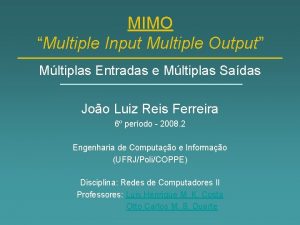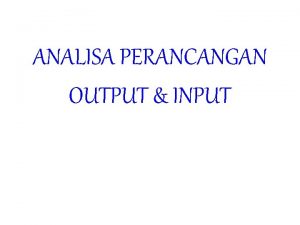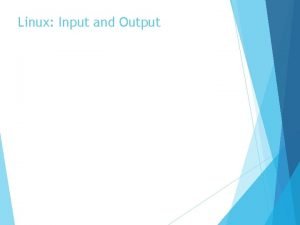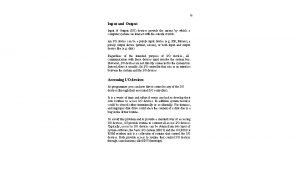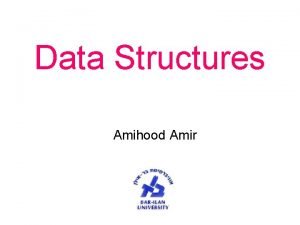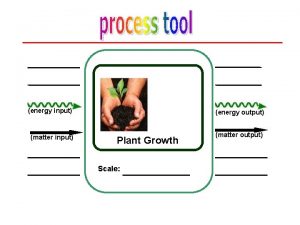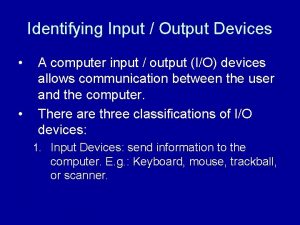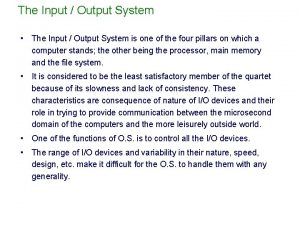Multiple Input Multiple Output MIMO MIMO is introduced


















- Slides: 18

Multiple Input Multiple Output

MIMO • MIMO is introduced fairly recently. • Will be used in 802. 11 n will be OFDM over MIMO. • The basic idea is simple – having multiple transmitting antennas and multiple receiving antennas.

MIMO • First, having multiple receiving antennas means that you can pick up more energy. • Also, when one antenna is having trouble receiving signal, others are unlikely to be having the same problem. That is why commercial APs sometimes have multiple antennas also. It compares the received signal strength from different antennas and use the strongest one to decode the data. Called ``antenna diversity. ’’ • As long as the antennas are sufficiently apart from each other, the signals are likely experiencing different fading. The space needs to be half of the carrier wavelength. If we are using 2. 4 GHz, the wavelength is about 10 cm.

MIMO • Having multiple transmitting antennas does not necessarily mean that you can send more energy, because the transmitting energy is determined by other issues, such as your battery. • However, it does mean that you can have multiple paths between the sender and the receiver. With nt transmitting and nr receiving antennas, you have nt times nr paths that can be assumed to be independent. If one path is in trouble, i. e. , there is someone in the blocking position right now, other paths are unlikely to be in the same situation at the same time. Much better than depending everything on only one path! • Also, what makes MIMO possible is that the receiver antennas can operate in the linear range such that the received signal is the ADDITON of signals from multiple transmitting antennas. • So, based on these high-level intuitions, MIMO is likely able to improve the performance. But how exactly?

SIMO • Single Input Multiple Output. • Consider one transmitting antenna and two receiving antennas. • Assume flat-fading, meaning that there is no multi-path, i. e. , the received sample is relevant only to the current data symbol. We write it as y[n]=x[n] + w[n]. • We can make this assumption because of OFDM.

SIMO • With two receiving antennas, we will receive that is, from the waveform received at each antenna, we can take a sample, and call it y 1 and y 2, respectively. Both samples are excited by x, but they are from different paths, therefore their channel coefficients (i. e. , h 1, h 2) are different. One important thing to remember is that the noise from both antennas are usually assumed to be following the same distribution and have the same power and are independent from each other.

SIMO Receiver • For the simplest receiver, let’s just add y 1 with y 2 and make a decision. • Is this the optimal one? – What if h 1=10 while h 2=1 (yes, this is possible!)? Remember that the noises are the same (random but following the same distribution) at both channels). Assume the data is 1 (BPSK), and this moment, the noises at both channels are -6. So, we will get (10+(6)) + (1+(-6)) = -1, and we will think the sender sent 0! – What is the problem? If we only use the strong channel we won’t make the wrong decision!

SIMO receiver • The problem is that we are treating the information from a good channel and a weak channel in the same way. • The information from the strong channel is more valuable than the weak channel. • The optimal -- Maximum Ratio Combining (Section 3. 2. 1 in the Tse book). We should weight the samples from the antennas according to the channel strength:

MISO • Now consider the case when the sender has multiple antennas and the receiver has only one antenna. • The sender has a power budget – the total transmitting power cannot exceed a threshold. • Assume that all antennas are sending the same data symbol at any time, so the receiver will receive where a 1 and a 2 represent the power allocated for antenna 1 and antenna 2, respectively.

MISO • The problem is to maximize the magnitude of the received signal x(h 1 a 1+h 2 a 2) subject to the constraint that • Any ideas?

MISO • Still maximum ratio combining. Define Lagrange • Take the partial derivative of L over a 1 and a 2 : • Means that a 1 and a 2 should be proportional to h 1 and h 2. • But this requires the sender knows the channel – not always the case.

The Altamonte Scheme • The key is that the transmitting antennas are NOT restricted to sending the same data symbols at the same time. • The Altamonte Scheme (Tse book Section 3. 3. 2). Consider two data symbols to be sent in two consecutive symbol times, u 1 and u 2. At time 1, ant 1 transmits u 1 and ant 2 transmits u 2. At time 2, ant 1 transmits –u*2 and ant 2 transmits u*1.

The Altamonte Scheme • (These two formulas are from the Tse book. ) So, • Rearrange it, we have

The Altamonte Scheme • So, we have • Note that is, the two vectors are orthogonal to each other. So, to recover u 1 and u 2, we can multiply with the conjugate of either of the vectors.

The Altamonte Scheme • So, the magnitude of the received signal is proportional to , even when the transmitter is not aware of the channel coefficient at all. • If the transmitter simply sends the same symbol over two antennas at the same power, the received signal is proportional to h 1 + h 2 , and depends on the phase, they may cancel each other out!

2 by 2 MIMO • Now consider we have two transmitting antennas and two receiving antennas. • A simple scheme called ``V-BLAST: ’’ Send independent data symbols over the transmitting antennas as well as over time.

MIMO • MIMO receiver. Will receive two samples per time slot. hij: the channel coefficient from Tx ant j to Rx ant i. • How to decode the data?

MIMO receiver • The simplest receiver just do a matrix inversion: • This is NOT the optimal decoder! The maximum likelihood decoder is better.
 Mimi me mima
Mimi me mima Não caracteriza a estética parnasiana
Não caracteriza a estética parnasiana Cours mimo
Cours mimo Amore di cinisca
Amore di cinisca Lopta mimo hry
Lopta mimo hry Mimo
Mimo Mass mimo
Mass mimo Vklad postaveny do hry
Vklad postaveny do hry Parnasianismo slide
Parnasianismo slide Mimo
Mimo Scope and delimitations example
Scope and delimitations example Accessing input output devices
Accessing input output devices Pseudocode for baking a cake
Pseudocode for baking a cake Ipo chart programming example
Ipo chart programming example Input dan output glikolisis
Input dan output glikolisis Piso shift register circuit diagram
Piso shift register circuit diagram Is a dot matrix printer an input or output device
Is a dot matrix printer an input or output device Input system output
Input system output Hardware output komputer
Hardware output komputer


